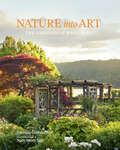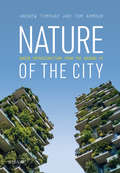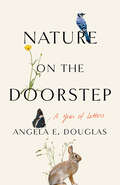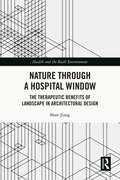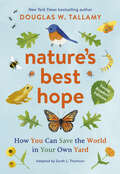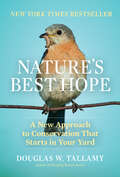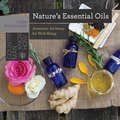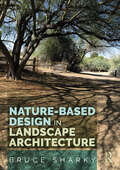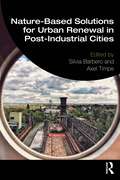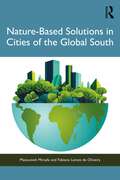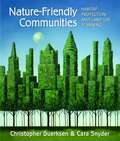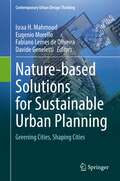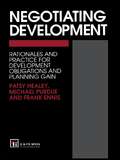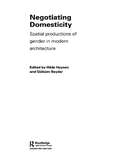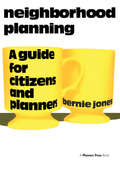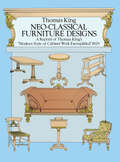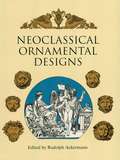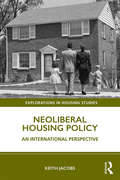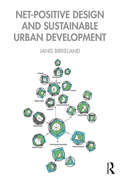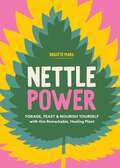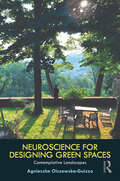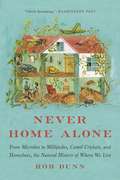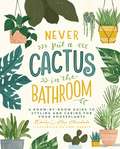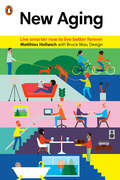- Table View
- List View
Nature into Art: The Gardens of Wave Hill
by Thomas Christopher“Like Wave Hill itself, these pages make an indelible impression—wildly intimate, possibility-laden, provocative—leaving me wide awake and hungry for a visit.” —Margaret Roach, author of A Way to Garden Wave Hill, a world-renowned public garden in the Bronx, boasts a classic horticultural craftsmanship unrivaled among other public gardens in the United States. But it also embraces a design spirit that is daring and innovative. Every year brings changes to Wave Hill: new combinations of colors, textures, and forms, along with creative themes and constant experimentation. Nature into Art brings this splendid, sensory experience home by honoring the unsurpassed beauty of Wave Hill. It explores the different areas of the garden—the flower garden, the shade border, the wild garden, the conservatory, and more—and gives gardeners helpful information on the plants, techniques, and design choices that define this iconic space. Filled with stunning, ethereal photography by Ngoc Minh Ngo, Nature into Art will enchant and inspire you to practice the Wave Hill way of gardening.
Nature of the City: Green Infrastructure from the Ground Up
by Tom Armour Andrew TempanyThis is a practical guide to delivering green infrastructure from the ground up and bringing nature in to the built environment. Exploring the process of delivery through an array of design approaches and case studies, it demystifies the concept and provides the tools for practical implementation - highlighting the challenges and opportunities on both small and large projects.
Nature on the Doorstep: A Year of Letters
by Angela E. DouglasNature on the Doorstep reveals the simple pleasures of paying attention to the natural world in one's own backyard over the course of a year. In weekly letters, Angela Douglas shares the joys and curiosities of a decidedly ordinary patch of green in upstate New York cultivated through the art of "strategic neglect"—sometimes taking a hand to manage wildlife, more often letting nature go its own way. From the first flowers of spring to cardinals singing in the winter, Douglas shows us the magic of welcoming unexpected plant and animal life into one's backyard. A paean to the richness we find when we stop to look and let be, Nature on the Doorstep celebrates the role humble backyards play both in conservation efforts and in an expanded appreciation of the living world.
Nature through a Hospital Window: The Therapeutic Benefits of Landscape in Architectural Design (Health and the Built Environment)
by Shan JiangAdopting an evidence-based approach, this book uses two state-of-the-art experimental studies to explore nature’s therapeutic benefits in healthcare environments, emphasizing how windows and transparent spaces can strengthen people–nature interactions. High-quality, supportive, and patient-centred healthcare environments are a key priority for healthcare designers worldwide, with ageing populations creating a demand for remodeled and updated facilities. The first study demonstrates individual psychophysiological responses, moods, and preferences in simulated hospital waiting areas with different levels of visual access to nature through windows, while the second experiment uses cutting-edge immersive virtual reality techniques to explore how gardens and nature views impact people’s spatial cognition, wayfinding behaviors, and experience when navigating hospitals. Through these studies and discussions drawing on architectural theory, the book highlights the important benefits of having access to nature from hospital interiors. This concise volume will appeal to academics and designers interested in therapeutic landscapes and healthcare architecture.
Nature's Best Hope (Young Readers' Edition): How You Can Save the World in Your Own Yard
by Douglas W. TallamyThis middle grade edition of the groundbreaking bestseller by Doug Tallamy will inspire kids to use their backyard to help save the planet. Douglas W. Tallamy awakened thousands of readers to an urgent situation: wildlife populations are in decline because the native plants they depend on are fast disappearing. His solution? Plant more natives. In this middle grade adaptation of the New York Times bestseller Nature's Best Hope, Tallamy outlines his vision for a grassroots approach to conservation that everyone can participate in regardless of age. In Nature's Best Hope (Young Readers' Edition), Tallamy empowers kids to use their own yards to help combat the negative effects of climate change. He does so by breaking down complex concepts into simple terms and real-world examples that kids can easily grasp. Black and white photographs help further clarify concepts. In addition to sharing the science, Tallamy encourages kids to take direct action. Some of these ideas include planting an oak tree (one of the most important tree species) at home. If that&’s too large of a task, he suggests they can plant asters—a beautiful flower whose pollen bees use to feed their young. By helping the next generation see that they have power and agency over our collective future, this empowering book will drive home the positive point that kids are truly nature&’s best hope.
Nature's Best Hope: A New Approach to Conservation that Starts in Your Yard
by Douglas W. Tallamy&“Tallamy lays out all you need to know to participate in one of the great conservation projects of our time. Read it and get started!&” —Elizabeth Kolbert, Pulitzer Prize-winning author of The Sixth Extinction Douglas W. Tallamy&’s first book, Bringing Nature Home, awakened thousands of readers to an urgent situation: wildlife populations are in decline because the native plants they depend on are fast disappearing. His solution? Plant more natives. In this new book, Tallamy takes the next step and outlines his vision for a grassroots approach to conservation. Nature&’s Best Hope shows how homeowners everywhere can turn their yards into conservation corridors that provide wildlife habitats. Because this approach relies on the initiatives of private individuals, it is immune from the whims of government policy. Even more important, it&’s practical, effective, and easy—you will walk away with specific suggestions you can incorporate into your own yard. If you&’re concerned about doing something good for the environment, Nature&’s Best Hope is the blueprint you need. By acting now, you can help preserve our precious wildlife—and the planet—for future generations.
Nature's Essential Oils: Aromatic Alchemy For Well-being (Countryman Know How #0)
by Cher KaufmannLavender is calming and relaxing; lemon uplifting and stimulating. But why do each of these scents provoke specific, visceral responses? In Nature’s Essential Oils, certified aromatherapist Cher Kaufmann demystifies the how and why behind essential oils, explaining the environmental factors that impact the chemical make-ups of herbs and plants and how they trigger our physical and emotional responses. This thorough and welcoming guide includes recipes for oil blends that can be used in diffusers and personal inhalers as well as for bath salts, salves, linen sprays, and more. Kaufmann also explains essential oil dilution and safety, shares the best carrier oils for each application, and includes tips for buying and storing oils. With detailed profiles of more than 30 of the most common essential oils for well-being, this is a valuable resource for anyone hoping to expand their knowledge of essential oils and their properties.
Nature-Based Design in Landscape Architecture
by Bruce SharkyNature-Based Design in Landscape Architecture showcases a range of built works designed by landscape architects from many countries of the world representing diverse environmental regions and uses. These projects demonstrate the transformative potential of a nature-based approach to landscape architecture.The nature-based design approach supports and encourages natural regeneration with a view to promoting sustainable environments, preserving natural resources, and mitigating the impacts of climate change and development. The projects selected for this book demonstrate the potential of nature-based landscape design to support healthy, natural and managed ecosystems, sequester carbon, and support the recovery of biodiversity. In addition to examples of design-led environmental interventions, Nature-Based Design in Landscape Architecture, the book, also demonstrates the potential for nature-based design to improve people’s relationship with their surroundings by encouraging them to be active participants in their communities. As such, each project featured in the book promotes a discussion around future scenarios in which landscape architects can and will be engaged, from minimizing environmental impact through sustainable design to fostering social justice through community engagement.This book will be a welcome supplement for undergraduate landscape architecture, survey or design studio courses, and may also be used at the master’s degree level either as part of a landscape architecture survey seminar or early design studio.
Nature-Based Solutions for Urban Renewal in Post-Industrial Cities
by Silvia Barbero Axel TimpeThis book, based on the experiences and insights gained during the Horizon 2020 project proGIreg, offers a detailed overview of targeted nature-based solutions and their impacts on various key sustainability areas, guiding readers through the spatial analysis, co-design, and implementation processes of cities in Europe and Asia. Chapters shed light on the challenges and opportunities encountered in each location, including Germany, Italy, Croatia, Bosnia and Herzegovina, Greece, Portugal, Romania and China. It also shares essential lessons learned and a wide range of indicators crucial for assessing the benefits of nature-based solutions on social innovation, circular economy, biodiversity, and health. Finally, the focus of this book shifts to the future of nature-based solutions as catalysts for new and green community economies as well as policies aimed at addressing climate change and urban renewal. The lessons and insights from the projects highlighted in this book will be valuable for urban planners and policymakers worldwide, as well as for a broader audience interested in nature-based solutions and urban regeneration.The Open Access version of this book, available at www.taylorfrancis.com, has been made available under a Creative Commons CC-BY 4.0 license.
Nature-Based Solutions in Cities of the Global South
by Masoumeh Mirsafa Fabiano Lemes de OliveiraThis book explores the practice of Nature-Based Solutions (NBS) in the cities of the Global South. NBS are recognized as a key strategy for achieving sustainable development, and they are being implemented in a variety of sectors such as urban planning, agriculture, forestry, and water management. They offer a wide range of benefits, but there is a gap between research and practice across cities from the Global South. This book promotes implemented urban NBS projects in the Global South to help identify region-specific challenges and opportunities, and to develop more effective and equitable solutions. The presented case studies support resilient planning in the Global South and significantly inform urban debates in the Global North. This book offers pragmatic policy and planning recommendations, providing decision-makers with clear guidance on implementing NBS in urban settings and transforming knowledge into actionable strategies for sustainable and resilient urban development.
Nature-Friendly Communities: Habitat Protection And Land Use Planning
by Cara Snyder Chris DuerksenNature-Friendly Communities presents an authoritative and readable overview of the successful approaches to protecting biodiversity and natural areas in America's growing communities. Addressing the crucial issues of sprawl, open space, and political realities, Chris Duerksen and Cara Snyder explain the most effective steps that communities can take to protect nature. The book: documents the broad range of benefits, including economic impacts, resulting from comprehensive biodiversity protection efforts; identifies and disseminates information on replicable best community practices; establishes benchmarks for evaluating community biodiversity protection programs. Nine comprehensive case studies of communities explain how nature protection programs have been implemented. From Austin and Baltimore to Tucson and Minneapolis, the authors explore how different cities and counties have taken bold steps to successfully protect natural areas. Examining program structure and administration, land acquisition strategies and sources of funding, habitat restoration programs, social impacts, education efforts, and overall results, these case studies lay out perfect examples that other communities can easily follow. Among the case study sites are Sanibel Island, Florida; Austin, Texas; Baltimore County, Maryland; Charlotte Harbor, Florida; and Teton County, Wyoming. Nature-Friendly Communities offers a useful overview of the increasing number of communities that have established successful nature protection programs and the significant benefits those programs provide. It is an important new work for public officials, community activists, and anyone concerned with understanding or implementing local or regional biodiversity protection efforts.
Nature-based Solutions for Sustainable Urban Planning: Greening Cities, Shaping Cities (Contemporary Urban Design Thinking)
by Fabiano Lemes de Oliveira Davide Geneletti Israa H. Mahmoud Eugenio MorelloUrban greening policies and measures have recently shown a high potential impact on the design and reshaping of the built environment, especially in urban regeneration processes. This book provides insights on analytical methods, planning strategies and shared governance tools for successfully integrating Nature-Based Solutions (NBS) in the urban planning practice. The selected contributions present real-life application cases, in which the mainstreaming of NBS are investigated according to two main challenges: the planning and designing of physical and spatial integration of NBS in cities on one side, and the implementation of suitable shared governance models and co-creation pathways on the other. Chapter 5 is available open access under a Creative Commons Attribution 4.0 International License via link.springer.com.
Negotiating Development: Rationales and practice for development obligationsand planning gain
by Frank Ennis F. Ennis P. Healey Prof Patsy Healey M. PurduePlanning gain is the legal process by which property development is linked to social provisions. This book examines the rationale for planning gain and development obligations and reviews the practice of development negotiation through a wide range of case histories.
Negotiating Domesticity: Spatial Productions of Gender in Modern Architecture
by Hilde Heynen Gülsüm BaydarIn the home the intricate relations between architecture, gender and domesticity become visible. Negotiating Domesticity investigates the many and complex themes evoked by the interconnections between these terms. Topics covered include famous as well as less well-known architectural examples and architects, which are explored from sociological, anthropological, philosophical and psychoanalytical approaches. The authors explore the relationships between modern domestic spaces and sexed subjectivities in a broad range of geographical locations of Western modernity. This richly interdisiplinary work presents architects and postgraduate students with an in-depth exploration of domesticity in the modern era.
Neighborhood Planning: A Guide for Citizens and Planners
by Bernie JonesFirst published in 1990. Routledge is an imprint of Taylor & Francis, an informa company. This guide explains neighborhood planning for both citizens and professionals. It explains what information to collect, where to get it, and how to assess it; how to pinpoint key issues, set clear goals, and devise strategies to achieve them; and how to package, implement, and update the final plan. Although this book could be used by citizens working alone, Jones advocates a team approach—citizens and professionals planning together. He highlights which tasks are best suited to the professional and how the planner should manage his role as intermediary between the city administration and residents. Jones also takes a detailed look at the neighborhood plan itself. Numerous maps illustrate how to inventory environmental features, land uses, circulation systems, and design features.
Neo-Classical Furniture Designs: A Reprint Of Thomas King's Modern Style Of Cabinet Work Exemplified, 1829
by Thomas KingInfluential guide displays over 300 Grecian designs: fire screens, sofas, couches, chairs, footstools, commodes, sideboards, washstands, bedsteads,and many other items.
Neoclassical Ornamental Designs
by Rudolph AckermannGraphic artists, illustrators, desktop publishers - anyone in search of elegant classical ornament - will find a wealth of usable material in this handy resource, reproduced from rare 19th-century portfolios. Readers can choose from borders, corners, vignettes, cartouches, busts, ornamental designs, and many other configurations depicting gods and goddesses, mythical animals, floral and foliate motifs, urns, chariots, helmets, angels and cherubs, columns, figures from classical mythology, and more - all in fine-line renderings that convey a sense of timeless elegance and classical ambience. Ideal for adding pictorial interest to book and magazine illustrations, advertisements, brochures, and many other projects, these designs comprise an easy-to-use, copyright-free reference that belongs at the fingertips of anyone wishing to create eye-catching graphics with a classical touch.
Neoliberal Housing Policy: An International Perspective (Explorations in Housing Studies)
by Keith JacobsNeoliberal Housing Policy considers some of the most significant housing issues facing the West today, including the increasing commodification of housing; the political economy surrounding homeownership; the role of public housing; the problem of homelessness; the ways that housing accentuates social and economic inequality; and how suburban housing has transformed city life. The empirical focus of the book draws mainly from the US, UK and Australia, with examples to illustrate some of the most important features and trajectories of late capitalism, including the commodification of welfare provision and financialisation, while the examples from other nations serve to highlight the influence of housing policy on more regional- and place-specific processes. The book shows that developments in housing provision are being shaped by global financial markets and the circuits of capital that transcend the borders of nation states. Whilst considerable differences within nation states exist, many government interventions to improve housing often fall short. Adopting a structuralist approach, the book provides a critical account of the way housing policy accentuates social and economic inequalities and identifies some of the significant convergences in policy across nations states, ultimately offering an explanation as to why so many ‘inequalities’ endure. It will be useful for anyone in professional housing management/social housing programmes as well as planning, sociology (social policy), human geography, urban studies and housing studies programmes.
Net-Positive Design and Sustainable Urban Development
by Janis Birkeland‘Sustainable’ urban planning, policy and design professes to solve sustainability problems, but often depletes and degrades ever more resources and ecosystems and concentrates wealth and concretize social disparities. Positive Development theory holds that development could create more net ecological and social gains than no construction at all. It explains how existing conceptual, physical and institutional structures are inherently biased against the preservation and expansion of social and natural life-support systems, and proposes explicit reforms to planning, design and decision making that would enable development to increase future options and social and natural life-support systems – in absolute terms. Net-Positive Design and Sustainable Urban Development is aimed at students, academics, professionals and sustainability advocates who wonder why existing approaches have been ineffective. It explains how to reform the anti-ecological biases in our current frameworks of environmental governance, planning, decision making and design – and suggests how to make these changes. Cities can increase both the ‘public estate’ (reduce social stratification, inequity and other causes of conflict, increase environmental quality, wellbeing and access to basic needs, etc.); and the ‘ecological base’ (sequester more carbon and produce more energy than used during construction and operation, increase ecological space to support ecological carrying capacity, ecosystem functions and services, restore the bioregions and wilderness, etc.). No small task, this new book provides academic theory and professional tools for saving the planet, including a free computer app for net-positive design.
Nettle Power: Forage, Feast & Nourish Yourself with This Remarkable Healing Plant
by Brigitte MarsA colorful, highly accessible guide to the healing and culinary uses of nettle, a protein-packed wild plant that is a favorite of foragers and herbalists.Nettle Power is a fascinating exploration of the many uses of nettle for food, medicine, and fiber. A plentiful wild plant with a long history of use by both European and Native American herbalists, nettle helps soothe skin conditions, strengthen bones, increase milk production in lactating mothers, restore the nervous system, purify the blood, and boost the immune system, among its many benefits. The plant's sting is easily neutralized by blanching and author Brigitte Mars shares a range of recipes for using the nutrient-dense green leaves as a tasty substitute for spinach or chard in salads, soups, and main dishes, along with healing recipes for teas, tinctures, juices, and elixirs. Colorful illustrations and curious facts and lore make this a highly browsable and useful handbook for foraging, herb, and natural health enthusiasts.
Neuroscience for Designing Green Spaces: Contemplative Landscapes
by Agnieszka Olszewska-GuizzoUrban parks and gardens are where people go to reconnect with nature and destress. But do they all provide the same benefits or are some better than others? What specific attributes set some green spaces apart? Can we objectively measure their impact on mental health and well-being? If so, how do we use this evidence to guide the design of mentally healthy cities? The Contemplative Landscape Model unveils the path to answer these questions. Rooted in landscape architecture and neuroscience, this innovative concept is described for the first time in an extended format, offering a deep dive into contemplative design and the science behind it. In the face of the global mental health crisis, and increasing disconnection from nature, design strategies for creating healthier urban environments are what our cities so sorely need. This book delves into the neuroscience behind contemplative landscapes, their key spatial characteristics, and practical applications of the Contemplative Landscape Model through case studies from around the world. Landscape architects, urban planners, students, land managers, and anyone interested in unlocking the healing power of landscapes will find inspiration here.
Never Home Alone: From Microbes to Millipedes, Camel Crickets, and Honeybees, the Natural History of Where We Live
by Rob DunnA natural history of the wilderness in our homes, from the microbes in our showers to the crickets in our basements <P><P>Even when the floors are sparkling clean and the house seems silent, our domestic domain is wild beyond imagination. In Never Home Alone, biologist Rob Dunn introduces us to the nearly 200,000 species living with us in our own homes, from the Egyptian meal moths in our cupboards and camel crickets in our basements to the lactobacillus lounging on our kitchen counters. You are not alone. <P><P>Yet, as we obsess over sterilizing our homes and separating our spaces from nature, we are unwittingly cultivating an entirely new playground for evolution. These changes are reshaping the organisms that live with us--prompting some to become more dangerous, while undermining those species that benefit our bodies or help us keep more threatening organisms at bay. <P><P>No one who reads this engrossing, revelatory book will look at their homes in the same way again.
Never Put a Cactus in the Bathroom: A Room-by-Room Guide to Styling and Caring for Your Houseplants
by Emily L. HinsdaleFuel your houseplant obsession with this beautifully illustrated room-by-room guide to bringing the outdoors inside—perfect for plant parents everywhere!Millions of plant lovers and newbie gardeners are discovering the joys of bringing plants into their homes. Not only do they add a fresh, natural touch to any room, they also have serious mood-boosting power, and help to reduce stress, improve air quality, and even provide fresh herbs for that next meal! It&’s a no-brainer that houseplants can improve our quality of life—but how do you maximize their benefits without sacrificing style. Full of home design and practical plant care tips as well as more than 70 plant recommendations, Never Put a Cactus in the Bathroom is an illustrated guide to help you choose the right plants for your space, from succulents and spider plants to pothos and ZZ plants. A Houseplant 101 section will set you off on the right foot, covering essentials of plant care and maintenance, as well as basic troubleshooting, and a primer on the health benefits of indoor plants. Then, going room by room, you will find space-specific recommendations, such as: -Purifying the air in your bedroom with low light beauties -Decorating your bathroom with air plants and ferns—your shower powers the climate is they need to thrive! -Creating a living centerpiece for your dining room or breakfast nook -Adding a low-maintenance bamboo or jade plant to your home office for motivation and focus -Growing a windowsill herb box or hydroponic tomato to level up your next meal Perfect for fans of Wild at Home, Urban Jungle, and Wellness by Design, this book will give plant lovers the tools and confidence they need to bring houseplants into every corner of their homes, improve their quality of life, and turn their home into a natural sanctuary.
Never Too Busy to Cure Clutter: Simplify Your Life One Minute at a Time
by Erin Rooney DolandMore than 365 tips to give you the advice and motivation you need to kick-start your home organizing project on your schedule.Whether you have thirty seconds, one minute, five minutes, or fifteen minutes, this organizing daily devotional offers tips, checklists, weekend projects, quizzes, and encouragement that will help you find the time, motivation, and permission to let go of sentimental clutter, set up storage solutions, and establish routines that make sense for your life.Filled with practical advice and small, doable projects that were created with your busy life in mind, Never Too Busy to Cure Clutter is a loyal resource, as well as a workbook, that you can rely on for straightforward, inspiring advice and tips you can return to time and time again.Yes, you’re busy, but you’re never too busy to cure clutter.
New Aging: Live Smarter Now to Live Better Forever
by Matthias Hollwich Bruce Mau DesignAging is a gift that we receive with life--and in New Aging, the architect Matthias Hollwich outlines smart, simple ideas to help us experience it that way. New Aging invites us to take everything we associate with aging--the loss of freedom and vitality, the cold and sterile nursing homes, the boredom--and throw it out the window. As an architect, Matthias Hollwich is devoted to finding ways in which we can shape our living spaces and communities to make aging a graceful and fulfilling aspect of our lives. Now he has distilled his research into a collection of simple, visionary principles--brought to life with bright, colorful illustrations--that will inspire you to think creatively about how you can change your habits and environments to suit your evolving needs as you age. With advice ranging from practical design tips for making your home safer and more comfortable to thought-provoking ideas on how we work, relax, and interact with our neighbors, and even how we eat, New Aging will inspire you and your loved ones to live smarter today so you can live better tomorrow.From the Trade Paperback edition.
